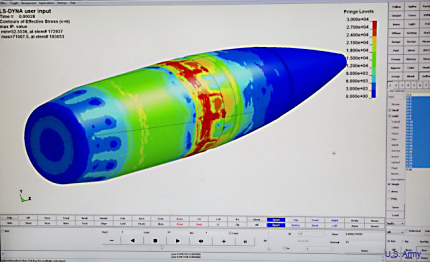Army researchers use simulations to make better bullets
ARDEC and the Army Research Lab use modeling to cut the time and expense of improving ballistics.

A structural launch model show the stress on the outer surfaces of a projectile as it travels through the barrel.
Defense Department researchers keep finding more uses for computer modeling and simulation, as computing power increases while its costs come down.
In one of the most recent examples, mechanical engineers and technologists have increased the effectiveness of rifle ammunition through computer-based analysis and simulations. Computer models leveraged statistical, physical and probabilistic data through physics-based models to simulate ballistics on soft targets to make the new 5.56 mm M855A1 Enhanced Performance Round – commonly found in infantry weapons such as the M-16, the M-4 Carbine or civilian variant AR-15 – a more consistent and lethal round.
"We are able to get a more detailed small-caliber lethality analysis with more advanced computer technology, by quantifying the numerous constituents of a ballistic event ending in the incapacitation of an individual," Mark Minisi, technology team leader at the Small Caliber Munitions Division of the Army Armament Research, Development and Engineering Center, or ARDEC, said in an Army release.
The development was a joint effort between ARDEC and the Army Research Laboratory, which contributed analytical work, modeling and simulation, laboratory and field experiments.
Advances in software and computing power help researchers to handle a larger work load more quickly, not to mention that virtual simulations are significantly less expensive as they save on development time and prototypes, which can cost millions of dollars. A simulation that would have taken a week to prepare 10 years ago takes about 20 hours now, ARDEC said.
While large caliber munitions testing has taken advantage of computer modeling, smaller munitions are arriving late to the party. The lag, according to the Army, was due to cost differentials in prototyping and testing between artillery and rifle munitions.
Computing has come a long way in a short time. In the not-so-distant past, engineers’ computers consisted of 32 processors and had an average cost of $500,000, as opposed to 100 processors averaging and an average cost of $100,000 at ARDEC today.
"They more we can do, the more we can realize all the things we can't do," Minisi said. "I can't model a whole human body … but we are much closer than we were 10 years ago."
The military services also are making greater use of simulations as a cost-effective method for training soldiers. Immersive simulators for training purposes allow for more efficient supervision as well as the ability to conduct instruction in a controlled environment where commanders can dial up tailored scenarios.




